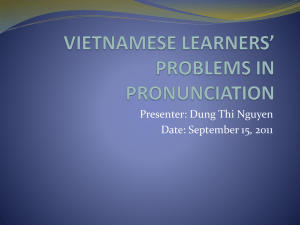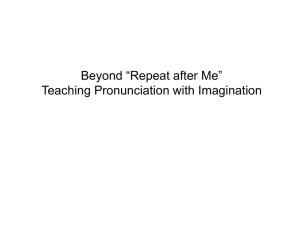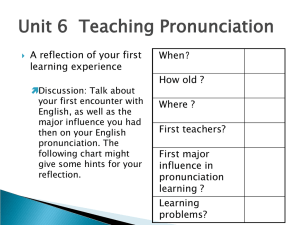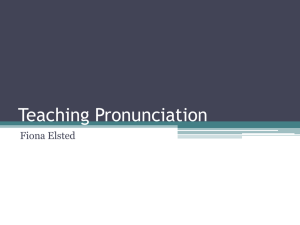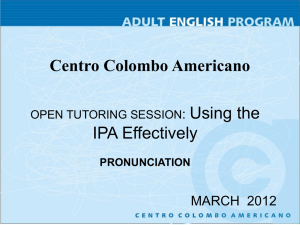PRONUNCIATION
advertisement
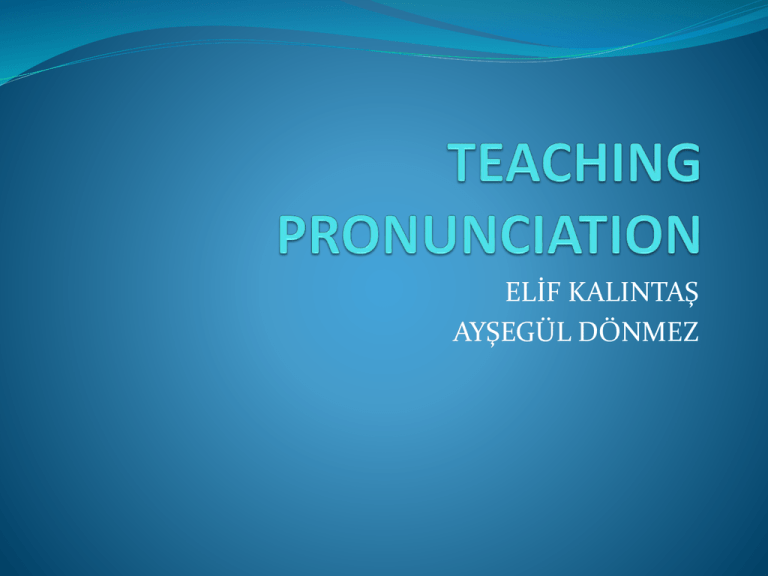
ELİF KALINTAŞ AYŞEGÜL DÖNMEZ CONTENTS What is pronunciation? What is pronunciation teaching? Why to teach pronunciation? What to know to teach? Pronunciation issues Perfection versus intelligibility Problems that can students encounter --What students can hear --The intonation problem When to teach pronunciation? Different materials and some teaching techniques How to teach pronunciation? Steps for teaching pronunciation. What is pronunciation? The Production of Significant Sound. Significant because it is used as part of a code of a particular language it is used to achieve meaning in contexts of use. Auditory Phonetics = The perception of the sound. Articulatory Phonetics = The production of the sound. What is pronunciation teaching? Pronunciation teaching not only makes students aware of different sounds and sound features can also improve their speaking immeasurably Showing where they are made in the mouth ,making students aware of where words should be stressed. Why teach? 4 major reasons to teach pronunciation ( Morley, 1999) functional intelligibility functional communicability increased self-confidence speech monitoring abilities Teach pronunciation to build on… Functional intelligibility: Spoken English in which an accent is not distracting to the listener. Functional communicability: learner’ s ability to function successfully within the specific communicative situations. Self-confidence: Dependent on the ones mentioned above. Speech monitoring abilities: Good learners listen to the input and try to imitate it. Problems that students can encounter It is very overlooked by teachers, It is overlooked in a lot of coursebooks – included in very small chunks, so teachers don’t see it as important. Difficult to teach in multilingual classes If it’s not tested, it’s not important. Some teachers think it iseasy, but it actually needs a lot of work. It’s often left until later Realism is required: perfection is unnecessary and largely unobtainable. Students may believe there’s no system to English pronunciation What to teach? Individual sounds (perhaps using the IPA – see below) Sound linking Connected speech (perhaps through songs) Weak forms (schwa) Voice – get them to imitate English speakers mispronouncing their L1 – gives them a feel for sounds / rhythm Syllable stress - highlight length, pitch, loudness, & vowel clarity Intonation Minimal pairs Chunking Pausing Rhythm Awareness of varieties of English. Awareness and recognition – production will come later When to teach prounciation Harmer (2000) suggests 4 alternatives • Whole lessons (prep needed) • Discreet slots (prep needed) • Short, separated bits of pron. Work • Integrated phases (prep needed) • In any lesson (liistning, grammaring, writng etc. ) esp. When you dealwith forms, you may draw sts.’ attentiton to pron. • Opportunistic teaching • Esp. during grammar, voc. Teaching it seems natural to allocate time to pron. teaching Pronunciation issues Teachers give more importance to study grammar and vocabulary Teachers get students to study listening and reading Teachers see that pronunciation teaching will only make things worse Teachers ignore benefits of pronunciation teaching Actually;Pronunciation teaching(a) makes students aware of different sounds and their features improves their speaking immeasurably allows students to get over serious intelligibility problems concentrates on sounds ,showing where they are made in the mouth ,making studens aware of where words should be stressed So; Receognizing all these things give them extra information about spoken English and help them achieve the goal of improved comprehension and intelligibility Being made aware of pronunciation issues will be immense benefit not only to their own production but also to their own understanding of spoken English. Perfection versus intelligibility Perfection depends very much on sts attitude to how they speak and how well they hear. many cultural factors for perfection for these cultural factors ; language teachers consider intelligiblity as the prime goal of pronunciation teaching.. So what is intelligibility in teaching pronunciation? The students should be able to use pronunciation which is good enough for them to be always understood. When being intelligibility a goal ; it suggest that some pronunciation features are more important than others; some sounds ,stressing words and phrases and intonation. ‘Realism is required: perfection is unnecessary and largely unobtainable.’ What students can hear? While learning English, if students have similar sounds in their mother tongue, they may be confused and misleaded. The intonation problem Intonation is a problem or not? Many people and teachers; find intonation difficult to hear 'tunes' or identify the rising and falling tones. --giving opportunuties by using tape --or through the way we ourselves model them. The key to successful pronunciation teaching,not much getting students produce correct sounds,but listen and notice how english is spoken. --Noticing is so important for pronunciation teaching. The use of different materials and some teaching techniques Why we use the phoenemic alphabet ? Aware of the different phoenemes Dictionaries For pronunciation games and tasks But you should not forget that you r students’ proficiency level is important when deciding to use of phoenemic alphabet. How can we use vocal organ chart? ıt is used for showing how we can produce sounds So; students understand better Help to noticing Minimal pairs; What are minimal pairs? pairs of words that have one phonemic change between them. How can we use them in our lessons? Let’s look at the example; Ship and chip Contrasting two sounds is very popular way of getting students to concentrate on specific aspects of pronunciation Sounds/∫/ and /t∫/ Some Teaching Techniques <<Contextualized minimal pairs: Sounds: This pen leaks. This pan leaks. Then, don’ t write with it. Then, don’ t cook with it. Stress: Is it a lemon tree? Is it elementary? No, an orange tree. No, it’ s advanced. c. Cartoons and Drawings d. Gadgets and Props Rubber band, dices, kazoos, cuisenaire rods e. Rhymes, poetry, jokes Jazzchants etc f. Drama g. Hands and body Clapping etc. Moving Imitating the body movements, gestures and facial expressions of another person (face-to-face, or on video) How to teach pronunciation? Integrate it into your lessons as much as possible Start with little steps, and build from there. Model the shape of the mouth, and ask them to think about their tongues and lips! Combine it with listening. Record your students’ voice and use it to focus on pronunciation issues. Use games. Mouth exercises – SS think it’s fun to laugh at the teacher Use different coloured pens, dots, connections, arrows… Exaggerate pronunciation Listen to the radio and imitate the accent Exaggerate sounds – it’s fun, and SS can feel the difference between them Cuisenaire rods fabulous for teaching word/sentence stress, intonation etc The steps for teaching pronunciation(a) Planning stage Teaching stage Planning stage (a) 3 questions that you should ask; Is it important? If yes; Collect the information about the feature you want to teach Spot the potential problems of Turkish learners Teaching stage; € Description/analysis/ contrast Listening discrimination Controlled practice (Teacher centered ,accuracy) Semi-controlled(Guided practice) Free practice (Communicative practice) Description/ analysis/contrast Description T. presents a feature showing where and how it occurs (sounds) how it occurs (stress and intonation) T. might use charts, vocal organ diagram, gadgets, hands etc. T. might use inductive or deductive rule presentation. Analysis Sounds ◦ Spelling ◦ Symbol:Phonemic symbols ◦ Examples Intonation ◦ Falling-rising intonation ◦ Symbol: Arrows ◦ Examples Stress ◦ Syllable, ◦ Symbol: Emphasis ◦ Examples Contrast T. introduces the confusing sound, stress/intonation pattern Draw sts’s attention to spelling/pronun differences More examples are provided Listening discrimination Minimal pair discrimination exercises # same /different # circle the one that you hear # circle the odd one out # sentence and find the one t. pronounces Other discrimination activs. # count the words that contain the specific feature etc. Controlled practice Sts.’ focus is almost completely on form # whole-class and T-SS and more pair-work activities # choral reading # poems, skits, rhymes, dialogues, dramatic monologues # tracking Semi-controlled (Guided) practice Sts.’ focus is not only on form but also meaning, grammar, communication More pair-work Freer practice (communicative ) T. should give a clear goal like “ While doing this drama scene pay special attention to contractions) # Role-plays, debates, interviews, simulations, drama scenes etc.
